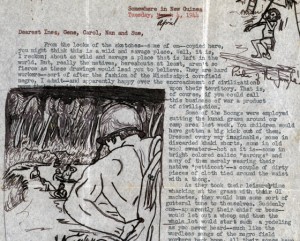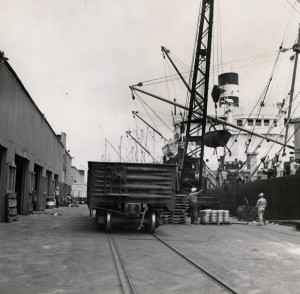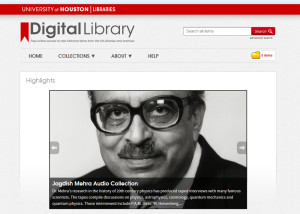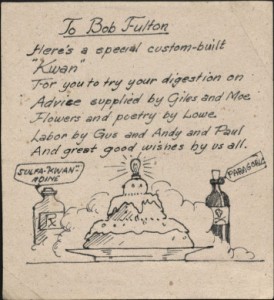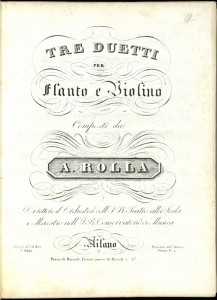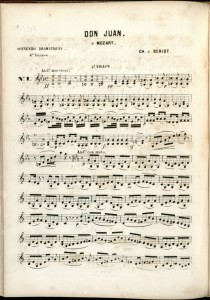
More good news from the good people over at our Digital Library! The digital collection of Captain O.C. McDavid’s World War II correspondence is now live and online.
An old-school Mississippi journalist, O.C. McDavid was born in Ruth, Mississippi in 1911 and started honing his newspaper chops in high school, sweeping the floor of a local print shop. As he pursued his journalism career, the outbreak of World War II brought about a fateful detour. Stationed in the Gilbert Islands, his letters home from the South Pacific resound with the wonder and insight of a professional writer.
A visual artist as well (McDavid would go on to become a prolific sculptor later in life), his letters home were often punctuated with sketches and drawings from half a world away. While the original materials have remained available for study in the Special Collections Reading Room, the work of the Digital Library allows patrons to remotely access and enjoy this distinct narrative of World War II.
You can find more information on O.C. McDavid and his writings online or in person.
Roll on, thou deep and dark blue Ocean – roll!
Ten thousand fleets sweep over thee in vain;
Man marks the earth with ruin – his control
Stops with the shore; – upon the watery plain
–Lord Byron, from Childe Harold’s Pilgrimage, canto II
In our youth, the world we inhabit is too large, too grand in our vision to fathom. As we grow older, we are amazed to find it shrinking and shedding some of its grandeur. We begin to find it more manageable, we devour it piecemeal, and dismiss the notion that anything was ever too large for us.
Occasionally, however, we are reminded.
The spectacles of nature remind us. The mysteries unlocked about ourselves remind us. Or, regardless of age, surveying a vast expanse of ocean and marveling at the unfathomable that envelops our little, blue rock, reminds us.
One of the joys of working with primary sources and artifacts of our past is that these seemingly small things still have the capacity to take us back there, remind us of how large and unwieldy the world is and how small but, at the same time, how significant and vital we each are. Recently the University of Houston Libraries received a communication from a patron conducting research in the Ship Channel Collection of our Digital Library. Upon discovering a photograph of an old friend, the SS Sue Lykes, she writes:
We can’t believe our luck at finding a photograph of the SS Sue Lykes in your collection. In 1954 the same vessel pictured unloading barbed wire on May 18th 1950 brought our family – Mother and three young girls – from London to Galveston (Dad had come over six months before on the Thompson Lykes and docked in the port of Houston. He had only just managed to earn the fare for us to come and wired it just in time to sail. We remember two other children on the ship, the Russian captain and several other passengers and crew. Lykes had very little, if any, cargo on board. The open expanded metal stairs were terrifying to climb and grandmother had to come behind us encouraging us up to the deck. We left London down the Thames, under the Tower Bridge and out to the sea – riding very high in a thick fog with the fog horn blasting – very exciting and frightening. It took us a month (approx. 15th November? to 16th December, 1954) to reach Galveston as we encountered an exceedingly violent North Atlantic storm, if not a hurricane. Bunk beds fell from the walls and my 6 year old mind wondered why the ship’s bow was going underwater. We upended a card table and slid across the cabin with the roll of the ship. I think there was some damage to the ship as repairs were made during the storm to something the first mate (who we liked because he gave us chocolate) had to scale. Veering southward towards the Azores to avoid any more difficulty, the ship crossed the Atlantic much further south than expected. Mom said she saw fires on the beach. We arrived in Galveston and saw that our Father was beside himself with worry. The ship had been out of contact. We know she has been scuppered and two or three have had her name by now, but we are so fond of that ship that brought us safely here.
With her recollection, an unassuming snapshot from the past is irreversibly altered. It becomes a reminder of the peril, wonder, and joy of youth — as well as the richness and warmth that comes through age and experience. As tiny as we can be, at times, we are still significant enough to bring about that sort of meaning and understanding to one another.
We thank our patron for sharing her story and take this opportunity to encourage you to do some exploration of your own — online or off. You never know what old friends you might find.
Mark your calendars fans of metadata and digitization!
The University of Houston Digital Library website is undergoing a redesign and will be unavailable beginning Thursday, July 18, 2013. The site is scheduled for relaunch, with full functionality, on Monday, July 22, 2013.
It is difficult not to fall in love with the University of Houston Digital Library. There are just not a whole slew of resources on this web of ours that offer the rich, deep selection of digitized materials to be found there. From high resolution reproductions of historic photographs and maps, to personal correspondence of prominent figures, as well as digitized audio and video resources, the Digital Library offers all of this, 24/7, gratis, as it provides wider and broader access for research and scholarship related to the University of Houston, the city of Houston itself, as well as the state of Texas.
Besides, where else can one find a photograph of that collegiate ice hockey power that was the University of Houston? The Digital Library is full of these hidden gems.
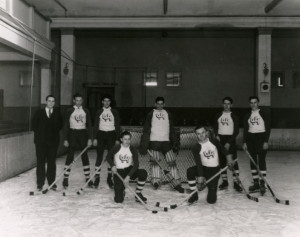
UH Men’s Ice Hockey Team, 1936, from the UH Photographs Collection, available for high resolution download in the Digital Library
As great as all of that is, it’s about to get better.
The redesign of the Digital Library has been ongoing, behind the scenes, for some time now (you can track the project’s arc and read more about it here). When they pull back the curtain we will be treated to a number of improvements based directly on patron feedback. Included in the redesign is a cleaner appearance, improved interface, and more flexibility in browsing and discovery of materials.
Want more information? A schedule of the website’s downtime, as well as anticipated improvements to the site, can be found at the Digital Library’s announcement here.
The latest digital collection containing materials related to the USS Houston, the Lt. Robert B. Fulton USS Houston Letters, is now available in the UH Digital Library. This collection contains letters Fulton wrote home prior to the sinking of the USS Houston (CA-30), along with other correspondence and documents.
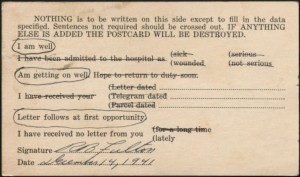
Fulton sent this postcard to his parents the week after the Japanese bombing of Pearl Harbor and the declaration of war on Japan by the United States.
Fulton was aboard the Houston when she was sunk by Japanese torpedoes in the Java Sea on Feb. 28, 1942, and he, along with more than 300 survivors of the sinking, was taken prisoner by the Japanese. Fulton spent most of the duration of the war in Zentsuji POW Camp in Japan before being liberated from Rokuroshi POW Camp on Sept. 7, 1945.
The heart of this collection is Fulton’s letters home. These provide insight into the experience of a naval officer on the USS Houston during the build up to war in the Pacific and during the conflict’s early months. Fulton describes daily activities on the ship, excursions and picnics, and the mounting tension in the area. Censorship prevents him from relaying the whereabouts or engagements of the ship.
Equally interesting are the colorful greeting cards Fulton received in POW camp, which contain handwritten messages and drawings.
Special Collections is dedicated to preserving and sharing the story of the Houston and her crew through archival and digital collections, as well as a permanent exhibit in M.D. Anderson Library. Additional digital library collections include the William Slough USS Houston Letters and the USS Houston Blue Bonnet Newsletters. While not related to the Houston, the Marine Bombing Squadron (VMB-613) Photos also contain World War II-related materials.
The original material for all these collections are available in Special Collections, which is open to the public. Be sure to take a look at these digital collections or come view the originals in our Reading Room.
The newest digital collection of Special Collections materials features a binder’s collection of sheet music dating to the late 18th and early 19th centuries. Sheet Music of Flute and Violin Duets, 1790s-1850s features a binder’s collection containing 27 duets for flute and violin.
Binder’s collections of sheet music were common in the 19th and early 20th centuries, providing the means to social entertainment in homes and other informal settings beyond concert venues. While often unorganized, some collections are ordered according to genre, instrumentation, composer or chronology.
The works of a number of composers are included in the collection, including composer and flautist François Devienne. Other composers include Friedrich Ludwig Dulon, Franz Alexander Pössinger, and Eugène Walckiers.
The sheet music also includes operatic transcriptions arranged by violinist Charles de Bériot, including a selection from Don Juan by Wolfgang Amadeus Mozart.
While the printed music is bound in two separate volumes, one for each instrument, the pieces have been combined in the digital collection so that both parts can be seen together.
Music lovers and anyone interested in this unique collection should spend some time with the digital collection, or visit Special Collections to see the original volumes.
